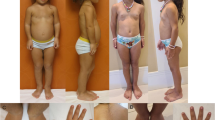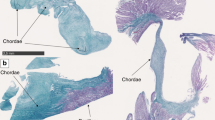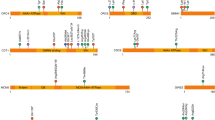Abstract
Acromesomelic dysplasia type Maroteaux (AMDM, OMIM #602875) is an autosomal recessive disorder characterized by severe short stature, shortened middle and distal segments of the limbs, redundant skin of fingers, radial head subluxation or dislocation, large great toes and cranium, and normal intelligence. Only the skeletal system appears to be consistently affected. AMDM is caused by biallelic loss-of-function variants in the natriuretic peptide receptor B (NPRB or NPR2, OMIM #108961) which is involved in endochondral ossification and longitudinal growth of limbs and vertebrae. In this study, we investigated 26 AMDM patients from 22 unrelated families and revealed their genetic etiology in 20 families, via Sanger sequencing or exome sequencing. A total of 22 distinct variants in NPR2 (14 missense, 5 nonsense, 2 intronic, and 1 one-amino acid deletion) were detected, among which 15 were novel. They were in homozygous states in 19 patients and in compound heterozygous states in four patients. Parents with heterozygous NPR2 variants were significantly shorter than the control. Extra-skeletal abnormalities, including global developmental delay/intellectual disability, nephrolithiasis, renal cyst, and oligodontia were noted in the patient cohort. The high parental consanguinity rate might have contributed to these findings, probably associated with other gene variants. This study represents the largest cohort of AMDM from Turkey and regional countries and further expands the molecular and clinical spectrum of AMDM.
This is a preview of subscription content, access via your institution
Access options
Subscribe to this journal
Receive 12 print issues and online access
$259.00 per year
only $21.58 per issue
Buy this article
- Purchase on Springer Link
- Instant access to full article PDF
Prices may be subject to local taxes which are calculated during checkout



Similar content being viewed by others
References
Mortier GR, Cohn DH, Cormier-Daire V, Hall C, Krakow D, Mundlos S, et al. Nosology and classification of genetic skeletal disorders: 2019 revision. Am J Med Genet A. 2019;179:2393–419.
Maroteaux P, Martinelli B, Campailla E. Acromesomelic dwarfism. Presse Med. 1971;79:1839–42.
Jurgen W Spranger PWB, Christine Hal, Gen Nishimura, Andrea Superti-Furga, Sheila Unger. Bone dysplasias an atlas of genetic disorders of skeletal development, Fourth Edition. New York: Oxford University Press; 2018.
Bartels CF, Bukulmez H, Padayatti P, Rhee DK, van Ravenswaaij-Arts C, Pauli RM, et al. Mutations in the transmembrane natriuretic peptide receptor NPR-B impair skeletal growth and cause acromesomelic dysplasia, type Maroteaux. Am J Hum Genet. 2004;75:27–34.
Potter LR, Hunter T. Identification and characterization of the phosphorylation sites of the guanylyl cyclase-linked natriuretic peptide receptors A and B. Methods. 1999;19:506–20.
Olney RC. C-type natriuretic peptide in growth: a new paradigm. Growth Horm IGF Res. 2006;16:S6–14.
Yasoda A, Nakao K. Translational research of C-type natriuretic peptide (CNP) into skeletal dysplasias. Endocr J. 2010;57:659–66.
Hume AN, Buttgereit J, Al-Awadhi AM, Al-Suwaidi SS, John A, Bader M, et al. Defective cellular trafficking of missense NPR-B mutants is the major mechanism underlying acromesomelic dysplasia-type Maroteaux. Hum Mol Genet. 2009;18:267–77.
Khan S, Ali RH, Abbasi S, Nawaz M, Muhammad N, Ahmad W. Novel mutations in natriuretic peptide receptor-2 gene underlie acromesomelic dysplasia, type maroteaux. BMC Med Genet. 2012;13:44.
Srivastava P, Tuteja M, Dalal A, Mandal K, SRP. Novel mutations in the transmembrane natriuretic peptide receptor NPR-B gene in four Indian families with acromesomelic dysplasia, type Maroteaux. J Genet. 2016;95:905–9.
Vera Saez-Benito MC, Izquierdo-Alvarez S, de Arriba Munoz A. New pathogenic variant in the NPR2 gene: etiology of low size, macrocephaly and bone dysplasia in a male with acromesomelic dysplasia Maroteaux-type. Med Clin. 2017;149:553–4.
Irfanullah, Zeb A, Shinwari N, Shah K, Gilani SZT, Khan S, et al. Molecular and in silico analyses validates pathogenicity of homozygous mutations in the NPR2 gene underlying variable phenotypes of Acromesomelic dysplasia, type Maroteaux. Int J Biochem Cell Biol. 2018;102:76–86.
Lin WD, Wang CH, Tsai FJ. Identification of one novel homozygous mutation in the NPR2 gene in a patient from Taiwan with acromesomelic dysplasia Maroteaux type. Pediatr Neonatol. 2018;59:322–3.
Tran TH, Cao MH, Luong LH, Le PT, Vu DC, Ta TD, et al. Acromesomelic dysplasia Maroteaux-type in patients from Vietnam. Am J Med Genet A. 2019;179:1420–2.
Ain NU, Iqbal M, Valta H, Emerling CA, Ahmed S, Makitie O, et al. Novel variants in natriuretic peptide receptor 2 in unrelated patients with acromesomelic dysplasia type Maroteaux. Eur J Med Genet. 2019;62:103554.
Wang W, Song MH, Miura K, Fujiwara M, Nawa N, Ohata Y, et al. Acromesomelic dysplasia, type maroteaux caused by novel loss-of-function mutations of the NPR2 gene: three case reports. Am J Med Genet A. 2016;170A:426–34.
Irfanullah, Umair M, Khan S, Ahmad W. Homozygous sequence variants in the NPR2 gene underlying Acromesomelic dysplasia Maroteaux type (AMDM) in consanguineous families. Ann Hum Genet. 2015;79:238–44.
Sag SO, Gorukmez O, Topak A, Gorukmez O, Ture M, Sahinturk S, et al. A novel mutation in Npr2 gene in a patient with acromesomelic dysplasia, Maroteaux type. Genet Couns. 2015;26:219–25.
Vasques GA, Arnhold IJ, Jorge AA. Role of the natriuretic peptide system in normal growth and growth disorders. Horm Res Paediatr. 2014;82:222–9.
Hachiya R, Ohashi Y, Kamei Y, Suganami T, Mochizuki H, Mitsui N, et al. Intact kinase homology domain of natriuretic peptide receptor-B is essential for skeletal development. J Clin Endocrinol Metab. 2007;92:4009–14.
Banapurmath CR, Patil M, Guruprasad G, Kesaree N. Acromesomelic dysplasia of the Maroteaux type. Indian J Pediatr. 1990;57:803–5.
Mustafa S, Akhtar Z, Latif M, Hassan M, Faisal M, Iqbal F. A novel nonsense mutation in NPR2 gene causing Acromesomelic dysplasia, type Maroteaux in a consanguineous family in Southern Punjab (Pakistan). Genes Genom. 2020;42:847–54.
Kant SG, Polinkovsky A, Mundlos S, Zabel B, Thomeer RT, Zonderland HM, et al. Acromesomelic dysplasia Maroteaux type maps to human chromosome 9. Am J Hum Genet. 1998;63:155–62.
Olney RC, Bukulmez H, Bartels CF, Prickett TC, Espiner EA, Potter LR, et al. Heterozygous mutations in natriuretic peptide receptor-B (NPR2) are associated with short stature. J Clin Endocrinol Metab. 2006;91:1229–32.
Chou JH, Roumiantsev S, Singh R. PediTools electronic growth chart calculators: applications in clinical care, research, and quality improvement. J Med Internet Res. 2020;22:e16204.
Neyzi O, Bundak R, Gokcay G, Gunoz H, Furman A, Darendeliler F, et al. Reference values for weight, height, head circumference, and body mass index in Turkish children. J Clin Res Pediatr Endocrinol. 2015;7:280–93.
Fryar CD, Gu Q, Ogden CL, Flegal KM. Anthropometric reference data for children and adults: United States, 2011–2014. Vital- Health Stat. 2016;3:1–46.
Utine GE, Taskiran EZ, Kosukcu C, Karaosmanoglu B, Guleray N, Dogan OA, et al. HERC1 mutations in idiopathic intellectual disability. Eur J Med Genet. 2017;60:279–83.
Haliloglu M, Ozen H, Kocak N, Unsal M. Acromesomelic dysplasia associated with mild lumbar spine stenosis. Eur Radio. 1999;9:103–4.
Plachy L, Dusatkova P, Maratova K, Petruzelkova L, Zemkova D, Elblova L, et al. NPR2 variants are frequent among children with familiar short stature and respond well to growth hormone therapy. J Clin Endocrinol Metab. 2020;105:e746–52.
Richards S, Aziz N, Bale S, Bick D, Das S, Gastier-Foster J, et al. Standards and guidelines for the interpretation of sequence variants: a joint consensus recommendation of the American College of Medical Genetics and Genomics and the Association for Molecular Pathology. Genet Med. 2015;17:405–24.
Daniele A, Scala I, Cardillo G, Pennino C, Ungaro C, Sibilio M, et al. Functional and structural characterization of novel mutations and genotype-phenotype correlation in 51 phenylalanine hydroxylase deficient families from Southern Italy. FEBS J. 2009;276:2048–59.
Lenke RR, Levy HL. Maternal phenylketonuria and hyperphenylalaninemia. An international survey of the outcome of untreated and treated pregnancies. N Engl J Med. 1980;303:1202–8.
Stevenson RE, Huntley CC. Congenital malformations in offspring of phenylketonuric mothers. Pediatrics. 1967;40:33–45.
Potter LR, Abbey-Hosch S, Dickey DM. Natriuretic peptides, their receptors, and cyclic guanosine monophosphate-dependent signaling functions. Endocr Rev. 2006;27:47–72.
Faivre L, Le Merrer M, Megarbane A, Gilbert B, Mortier G, Cusin V, et al. Exclusion of chromosome 9 helps to identify mild variants of acromesomelic dysplasia Maroteaux type. J Med Genet. 2000;37:52–4.
Tuncbilek E. Clinical outcomes of consanguineous marriages in Turkey. Turk J Pediatr. 2001;43:277–9.
Kurt-Sukur ED, Simsek-Kiper PO, Utine GE, Boduroglu K, Alanay Y. Experience of a skeletal dysplasia registry in Turkey: a five-years retrospective analysis. Am J Med Genet A. 2015;167A:2065–74.
Lal D, Neubauer BA, Toliat MR, Altmuller J, Thiele H, Nurnberg P, et al. Increased probability of co-occurrence of two rare diseases in consanguineous families and resolution of a complex phenotype by next generation sequencing. PLoS ONE. 2016;11:e0146040.
Posey JE, Harel T, Liu P, Rosenfeld JA, James RA, Coban Akdemir ZH, et al. Resolution of disease phenotypes resulting from multilocus genomic variation. N Engl J Med. 2017;376:21–31.
Nakajima M, Mizumoto S, Miyake N, Kogawa R, Iida A, Ito H, et al. Mutations in B3GALT6, which encodes a glycosaminoglycan linker region enzyme, cause a spectrum of skeletal and connective tissue disorders. Am J Hum Genet. 2013;92:927–34.
Acknowledgements
We thank our patients and their families for their collaboration and participation. We also thank Ebru Bulut for DNA sequencing, sample handling and excellent technical assistance. The study was supported by Hacettepe University Research Projects Management System with Project ID: 14392.
Author information
Authors and Affiliations
Corresponding author
Ethics declarations
Conflict of interest
The authors declare that they have no conflict of interest.
Additional information
Publisher’s note Springer Nature remains neutral with regard to jurisdictional claims in published maps and institutional affiliations.
Supplementary information
Rights and permissions
About this article
Cite this article
Simsek-Kiper, P.O., Urel-Demir, G., Taskiran, E.Z. et al. Further defining the clinical and molecular spectrum of acromesomelic dysplasia type maroteaux: a Turkish tertiary center experience. J Hum Genet 66, 585–596 (2021). https://doi.org/10.1038/s10038-020-00871-0
Received:
Revised:
Accepted:
Published:
Issue Date:
DOI: https://doi.org/10.1038/s10038-020-00871-0



